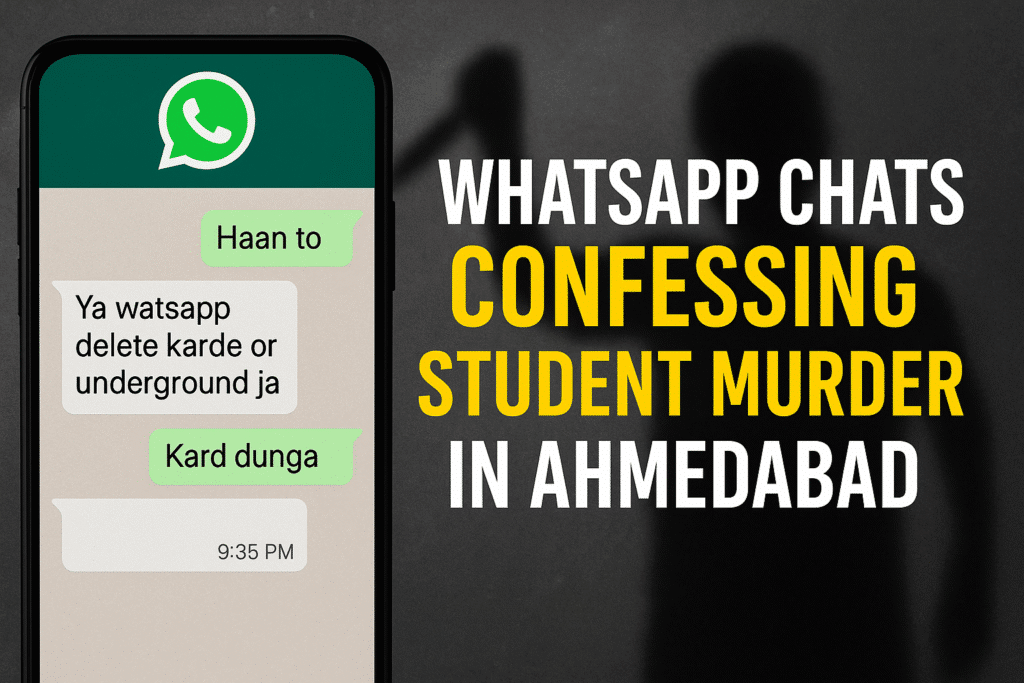Introduction
The Confessing Student Murder case in Ahmedabad has shocked the nation after viral WhatsApp chats revealed a teenage student allegedly admitting to stabbing his classmate. The disturbing digital evidence, now under police and cybercrime scrutiny, has sparked outrage among parents, protests in schools, and an urgent debate on student safety and digital accountability.
Key Points Summary
- Viral WhatsApp chats allegedly show the accused confessing student murder at an Ahmedabad school.
- The victim, 15-year-old Class 10 student Nayan Satani, was fatally stabbed on August 19, 2025.
- Screenshots shared over 4 million times across social media.
- Police and cybercrime experts now verifying the digital proof.
- Community outrage sparks protests and a petition with 25,000+ signatures for safer schools.
- Experts stress stronger digital literacy, student safety, and emotional regulation.
Background: A Shocking School Tragedy
The Ahmedabad confessing student murder case has gripped the city and drawn nationwide attention. On August 19, 2025, 15-year-old Nayan Satani, a Class 10 student at the Seventh-Day Adventist Higher Secondary School in Khokhra, was fatally stabbed on campus by a junior Class 8 student.
The shocking incident ignited widespread protests, with parents, students, and local community leaders demanding accountability from school authorities. Tensions escalated further when it emerged that the school allegedly delayed calling emergency services, summoning a water tanker instead of an ambulance.
Viral WhatsApp Evidence
Days after the incident, eight screenshots of WhatsApp chats began circulating widely across Twitter, Facebook, and WhatsApp groups.
- The chats, written in Hindi using English letters, allegedly show the accused confessing the stabbing.
- In one message, he admits his role and urges a friend to “delete the chats and go underground.”
- The screenshots quickly went viral, amassing more than 4 million shares online.
This viral confessing student murder evidence has now become central to the investigation.
Key Developments in the Case
1. Police Investigation
Ahmedabad Municipal Police have formally included the WhatsApp evidence in their forensic database. Senior detectives say the chats will be verified for authenticity before being used in court.
2. Cyber Forensics
Cybercrime commander Dr. Nikhil Rao confirmed that metadata — including timestamps, device IDs, and sender numbers — can be cross-referenced with the accused’s smartphone. Tools will confirm whether the screenshots originated from the device at the crime scene.
3. Witness Statements
The accused’s friend, identified as Vivek, was present during the altercation but denied any role. Witnesses agree he did not physically participate, though the chats show him encouraging the accused to “forget the past.”
4. Legal Filing
The Juvenile Justice Board (JJB) registered Case No. JJB/2025/001, charging the accused under Sections 302 (murder) and 307 (attempt to murder) of the IPC. A digital audit is ongoing.
5. Community Response
Local NGO Sudharni Trust launched a petition demanding digital safety education in schools. The campaign has already gathered over 25,000 signatures.
Impact on Students and Parents
The confessing student murder case highlights how digital conversations can influence real-world violence and later become admissible in court.
A 2023 study by Smith & Johnson found that 68% of students who shared hostile online messages later reported physical altercations. The Ahmedabad tragedy reinforces this trend — showing how online chats can become direct evidence of intent.
Parents, especially of international students, are now seeking clarity on:
- Digital monitoring policies in schools
- Secure communication channels for students
- Crisis response systems in case of on-campus violence
ALSO READ: Jyoti Chandekar Death News
Expert Insights: Staying Safe in the Digital Era
- Maintain Secure Digital Hygiene – Use end-to-end encrypted apps and avoid sending sensitive or incriminating content. (Manisha Patel, IT-Security Analyst)
- Record Evidence Offline – Keep a personal journal of disputes with dates and witnesses rather than relying solely on chats.
- Seek Legal Guidance Early – International students should consult legal aid offices to understand implications on visas.
- School Mitigation Policies – Introduce digital conduct codes, emotional intelligence workshops, and zero-tolerance for harassment.
- Use Separate Devices – Keep academic and personal communication on different devices to reduce legal risks.
Looking Ahead: Policy Shifts Expected
The Ahmedabad case is expected to trigger national reforms in student safety and digital accountability.
- The Ministry of Education has signaled plans to update student conduct rules.
- In 2026, the National Cyber Coordination Centre (NCCC) will launch a “Digital Safe School” initiative, featuring AI tools that detect violent or threatening language in real-time.
The judiciary’s upcoming decisions may also set important precedents on how WhatsApp chats and digital confessions are treated in criminal law.
Conclusion
The confessing student murder case in Ahmedabad is more than just a school tragedy — it is a wake-up call on the dangers of digital communication when combined with unresolved conflict.
By fostering digital literacy, emotional resilience, and accountability, schools and families can work together to prevent future tragedies.
The viral WhatsApp chats serve as a stark reminder: in today’s world, what is typed online can shape real lives, legal outcomes, and community trust.





